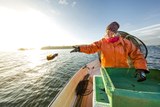Overview
Fisheries are composed of one or more parts, each of which is entitled to receive an MSC certificate. These parts or “units” are defined by their target stock(s), fishing gear type(s) and if relevant vessel type(s), and the fishing fleets or groups of vessels.
Attention
Some or all units that participated in this fishery are now covered by another assessment. Please see the Lake Mälaren, Lake Vänern, Lake Hjälmaren pikeperch fishery for more information.
Catch by Species
| Species | Reported Catch Year | Metric Tonnes |
|---|---|---|
| Pike-perch (Sander lucioperca) | 2021 | 190 |
Information is provided by an independent Conformity Assessment Body as live weight (the weight of species at the time of catch, before processing) and where a fishing season covers multiple years, the end year is given as the reported catch year. Additional information is available in the latest report, see the assessments page.
About this Fishery
In August 2006, the pikeperch fisheries of picturesque Lake Hjälmaren in South Sweden became the first freshwater fisheries and first Swedish fisheries to be certified as sustainable.
Pikeperch, also known as zander, are pelagic fish inhabiting freshwater reservoirs, lakes and rivers. They thrive in rather low visibility and are very active at night. They are fast predators and grow relatively quickly. They may reach 20kg in size, though typical catches are considerably smaller. The flesh of this fish is white, juicy and tender and contains little fat.
Most of the year pikeperch are caught with traps. During the winter when the lake is frozen, fishers cut holes in the ice and set gillnets. The two methods are assessed as separate fisheries.
In response to falling fish stocks, in 1994 fishers on Lake Hjälmaren increased the minimum size of pikeperch to 45cm (compared to 40cm elsewhere) and the mesh size of gill nets to 60cm, meaning even larger fish could escape and mature for longer. They also limited the number of fishing licences on the lake to 25.
Trap size and depth is regulated and fish sorted quickly to reduce predation by gulls and ensure unwanted fish caught in the traps can be returned to the water alive. In the gill nets, the mesh size avoids capture of undersized pike perch. Other fish species caught in these nets are pike, occasional large perch and bream. Perch and pike are landed and sold for human consumption, while the bream are used as bait in crayfish traps.
"Sweden has more than 100,000 lakes and most of its people live close to some kind of water. Fishing has always been an integral part of Swedish society. To make sure it stays this way the fishers at Lake Hjälmaren have opted for MSC certification. Their understanding and consideration of the lake's ecosystem has now been rewarded and they hope that this recognition will open new markets in Europe."
- Inger Näslund, Marine and Fisheries Conservation Officer, WWF-Sweden
Fisher Anna Vesper Gunnarsson fishing pikeperch image © Ulf Berglund/MSC
Pikeperch / zander (Sander Lucioperca) image © Scandinavian Fishing Year Book
Market Information
Around 80% of the pikeperch goes to Hjälmarfisk in Gothenburg, a supplier with MSC chain of custody who sells it on, mainly to Germany.

